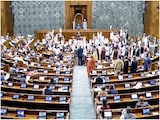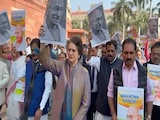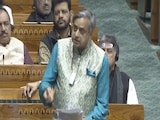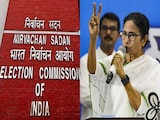Act Four in the weekly "yellow vest" protests unfolded Saturday in Paris amid a now-familiar backdrop of tear gas and chants, but also brought further clarity on where the rage is headed: directly at President Emmanuel Macron.
What began as opposition against a carbon tax designed to curb climate change has morphed into a working-class revolt against Macron, who now faces the first major test of his presidency and whose approval ratings have plummeted to personal all-time lows.
The crowds on Saturday - several thousand demonstrators - appeared smaller than past weeks.
But the increased focus on Macron and his perceived elitist image point to deeper divisions in France that reach beyond the current protests and could become defining features of the opposition as Macron's popularity slumps.
Yellow vest protests: Emmanuel Macron, decried by protesters as the "president of the rich", has seen a slump in popularity
Chants of "Macron resign!" echoed along the grand Champs Elysees on Saturday as protesters decried him as the "president of the rich" who has ignored struggling regions around the country.
Remarkably, some of those in the crowd had backed Macron's improbable campaign in 2017. But they now say they feel betrayed by an agenda they see as merely concerned with protecting the economic interests of the elite.
Last week, the protests reached a level of violence unseen since the student uprisings of 1968, with participants destroying shop windows across the capital and vandalizing national monuments, notably the Arc de Triomphe, an enduring symbol of the French Republic.
This Saturday, police barricaded access to the monument at the top of the Champs Elysees to avoid a repeat of last week, when protesters smashed parts of the Arc and scrawled graffiti on its gray limestone.
The government dispatched 89,000 police forces throughout the country - 8,000 of which were on patrol in Paris.
The protest on the Champs Elysees did not feature levels of violence of the week before, although riot police did frequently use tear gas to disperse large crowds of protesters, and disturbances spilled over into other areas. Arrests, however, were at a record high: the Paris prefecture announced by midafternoon that authorities had detained more than 670 people. In total, more than 1,000 people were arrested across France.
The movement - whose name is taken from the trademark high-visibility yellow vests - has since come to represent a deeply rooted social anger that has more to do with the personality of Macron than it does with any particular policy.
Most protesters tend to be white and many from the provinces - sharing anxiety over dwindling purchasing power and what they see as Macron's aloof style.
Unlike the United States, France provides its citizens with a generous amount of social services, but the median national salary is approximately 20,520 euros ($23,350), sometimes with additional charges to pay, according to the most recent statistics. Even if, for example, the country's health system is largely free, the average citizen does not enjoy a high level of disposable income.
By contrast, the median personal income in the U.S. is slightly higher, but without the sweeping state benefits.
The Yellow Vest protests has since come to represent a deeply rooted social anger that has more to do with the personality of Emmanuel Macron than it does with any particular policy
Macron has been repeatedly portrayed as insensitive to people struggling in France's economy. One of his first orders of business was slashing France's famously steep wealth tax and introducing a flat tax on capital gains.
His labor reforms have made it easier for certain companies to hire and fire employees, largely to streamline an economy in which unemployment is still relatively high. And he has also set his sights on welfare spending.
Severine Faucher, 43, stood with her 10-year-old son on the Champs Elysees outside a cavernous Louis Vuitton store, whose towering glass windows were covered with a protective layer of steel lattice. Some of the brand's famous printed purses were still visible inside. As police fired an early round of tear gas on the other side of the street, she helped her son with a gas mask.
"We no longer have the fruits of our labor," she said, noting that she and her husband, from Bretagne, earn 2,000 euros ($2,276) per month to support a family of five. They both jobs that require at least 55 hours of work, she as a medical aid assistant in a retirement home.
"I'm 43 years old, and this only is the second time in my life that I've seen Paris, but we wanted to be here," she said, nothing that they had come 500 kilometers from far western France.
When asked if she feared for her son's safety, she shook her head: "If it gets really bad, we'll take him away."
For Corinne Letondeur, 55, Macron - a former investment banker - has insulted the lives of working people too many times.
"He is only interested in the rich," she said, noting that she was an off-duty police officer in the Paris region. "For the little people there's nothing to do but this. He's not a president who wants anything to do with us."
She noted that she had voted for the far-right Marine Le Pen in the 2017 presidential election and would do so again. But this was hardly the political profile of everyone gathered on the Champs Elysees on Saturday.
Catherine Van Mikel, 66, a retired clerk at the Galeries Lafayette department store in Paris, noted that she had proudly voted for Macron in 2017. "I feel genuinely deceived," she said, standing toward the back, far from the jeering crowds.
"There's a real arrogance to him," she said of Macron. "I have never seen a president like that."
As it has been at many of the previous yellow vest marches, the crowd on Paris in Saturday was largely white. Although France's rural and provincial communities are far less diverse than its cities, many from minority communities also suffer socioeconomically but have been little seen in recent demonstrations.
The yellow vest protests have drawn immediate comparisons with even larger protests in October and November 2005, when many young French citizens of North African and African origins protested what they considered to be racially motivated police brutality in the Paris suburbs and elsewhere. Although not in central Paris, those riots saw more violence, more arrests and a stronger government response, including an official "state of emergency."
"There were protests in 2005, and actually nobody cared," said Rokhaya Diallo, a filmmaker and prominent French activist for racial and gender equality.
"I think the feeling is that people from the suburbs don't feel like they would be heard if they protested this way," Diallo said.
"Justice for Adama," a movement launched after the 2016 death of Adama Traorw, a 24-year-old black man killed by police, joined forces with the yellow vests on Saturday.
Approximately 290,000 people protested during the first weekend of demonstrations last month, fewer than half that amount took to the streets last weekend and even smaller crowds turned out Saturday. By the early afternoon, the Interior Ministry announced that 31,000 had mobilized across France, with approximately 8,000 demonstrators in Paris. Approximately 55 people were injured in riots across Paris.
Yet the images of violent clashes have riveted attention around the world. "Protests and riots all over France," President Donald Trump wrote Saturday on Twitter, claiming that the demonstrations reflected a rejection of global climate change action.
But another protest - the March for the Climate - was also slated for Saturday. Some in yellow vests were seen among the gathering, and more people turned out for the climate march than for the yellow vests.
According to statements by organizers, as many as 25,000 marched for the climate, more than three times the number of those in yellow vests.
(Except for the headline, this story has not been edited by NDTV staff and is published from a syndicated feed.)














